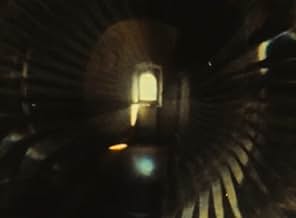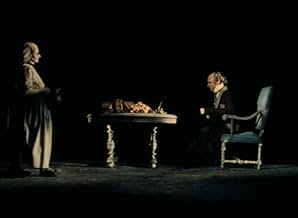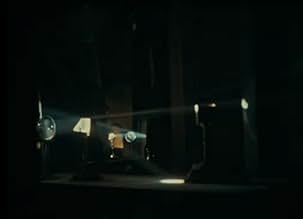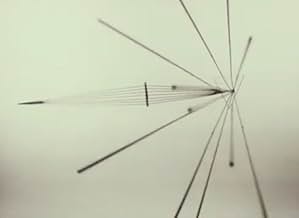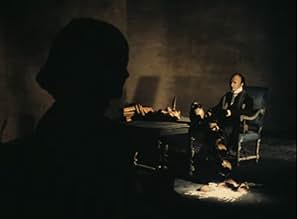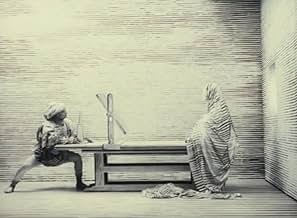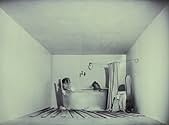Füge eine Handlung in deiner Sprache hinzuA surreal, nightmarish collection of imagery.A surreal, nightmarish collection of imagery.A surreal, nightmarish collection of imagery.
- Regie
- Drehbuch
- Hauptbesetzung
- Auszeichnungen
- 1 Nominierung insgesamt
Empfohlene Bewertungen
This is modeled after the thought that this much sought after thing we call pure cinema is images heaped together. Plenty of these circulate in the 'arthouse' strata. These may be perfectly good as art and aesthetic subject but generally make for shoddy cinema by the definition of the word; after the Greek word 'cinematograph' meaning 'motion + eye + to write'.
To write for the eye, to write with images, it means to structure. The eye as a needle that threads the world together. This doesn't mean it has to be constrained or linear or something we only reason with one way. The great Japanese tea masters for example were some of our most cinematic minds and they understood that purity flows best from unfinished structure.
The filmmaker was probably familiar with a similar notion and decided to experiment. He knows there has to be rhythm and visual beat. We get a few vignettes that paint a life of interminable drudgery and whimsical darkness; a masked man swinging a sword against a doll held up by a string; an old woman endlessly fetching a pot of milk that shatters every time; another man taking a bath and striking poses once finished; librarians at work cataloguing books. The rest is a shapeshifting swirl of light and shadow, presumably the cinematic purity that we are meant to flow into.
Maybe this will work for you as a work of abstract imagination or as the equivalent of what is known in music as power electronics. Maybe it will tap into some other part of you. It doesn't for me. I want a dream embedded with what triggers it. Painting where every stroke reveals a world as it comes into being. The scenery could be anything from mundane life around the corner to the most novel imagination, so long as the mechanisms are true as we know them to be.
There is none of that here, no mechanisms. Just a swirl that is no more erudite or revealing than Transformers' swirl of mechanized warfare.
This is reminiscent of early Lynch, and perhaps influenced later films. But Lynch grew, he learned to structure his dreams. Hopefully this filmmaker did as well. This is feverishly inventive babble. Visual non-sense.
To write for the eye, to write with images, it means to structure. The eye as a needle that threads the world together. This doesn't mean it has to be constrained or linear or something we only reason with one way. The great Japanese tea masters for example were some of our most cinematic minds and they understood that purity flows best from unfinished structure.
The filmmaker was probably familiar with a similar notion and decided to experiment. He knows there has to be rhythm and visual beat. We get a few vignettes that paint a life of interminable drudgery and whimsical darkness; a masked man swinging a sword against a doll held up by a string; an old woman endlessly fetching a pot of milk that shatters every time; another man taking a bath and striking poses once finished; librarians at work cataloguing books. The rest is a shapeshifting swirl of light and shadow, presumably the cinematic purity that we are meant to flow into.
Maybe this will work for you as a work of abstract imagination or as the equivalent of what is known in music as power electronics. Maybe it will tap into some other part of you. It doesn't for me. I want a dream embedded with what triggers it. Painting where every stroke reveals a world as it comes into being. The scenery could be anything from mundane life around the corner to the most novel imagination, so long as the mechanisms are true as we know them to be.
There is none of that here, no mechanisms. Just a swirl that is no more erudite or revealing than Transformers' swirl of mechanized warfare.
This is reminiscent of early Lynch, and perhaps influenced later films. But Lynch grew, he learned to structure his dreams. Hopefully this filmmaker did as well. This is feverishly inventive babble. Visual non-sense.
Blessed are those filmmakers experimental, avant-garde, and otherwise empathically artistic, for they labor and create without true or substantial appreciation. This isn't the first such picture that I've watched, and I'm sure it won't be the last. I'm sure it won't be the last despite what I readily admit is great difficulty on my part in extracting anything from what filmmaker Patrick Bokanowski and his collaborators have put together here. Once again I find myself surmising that for those viewers who are open to the most abstruse, abstract, and esoteric of creations in any artistic medium, and in cinema specifically, this is surely a must-see. For anyone else, no matter how ardent a cinephile or how willing to try new things, 'L'ange' is going to be much more of a hard sell.
I'll say this much: I absolutely admire Bokanowski's process of creation, and all the obvious intelligence and hard work that went into this. Everything here looks and sounds amazing. Michèle Bokanowski's score, unconventional and experimental in its own right, is surely one of the chief highlights, lending an uneasy atmosphere to the tableau with its dynamic ambience. Much of the imagery to present seems to follow much the same ethos, in fact, as exceptional and exquisite editing, cinematography, and use of light and shadow fosters somewhat dark and foreboding airs about it all. Much of what Bokanowski feeds us is plainly beautiful in and of itself, and more so for the clear meticulousness of its craft - and nonetheless is also often obliquely, indescribably unsettling. If this were a title of discrete narrative fiction, significant portions of these 64 minutes could readily be inserted as rapid-fire imagery of the sort that is often employed to portend grim supernatural visions, harrowing dreamscapes, and the like, or even serve just as readily as the basis for the art direction in any such title. Whether illustration, stop-motion animation, or live footage that has been shrewdly manipulated, the visual presentation is honestly rather magnificent in and of itself, both inherently enticing and also providing apt nightmare fuel.
Only: what does it all mean? What is the takeaway supposed to be here? Of course such works are intended for interpretation, letting the audience derive from the experience what they will even as the creator has distinct notions in mind. Indeed, I recognize definite motifs throughout, primarily in the regular appearance of stairs, and light seen from a distance or from the other side of objects or persons in the way. I think I can almost discern themes and bigger ideas underlying and unifying the visuals, like trying to determine who or what something is by the shadow that it casts. This is a whole lot of "almost" and "trying" on my part, though, without productive results. And there's the trouble for me; beautiful and entrancing as this is, and eliciting certain feelings just in the presentation itself, I get nothing deeper from it, and I know I'm supposed to. Maybe that says more about me than about 'L'ange,' in fairness, but I'm sure I'm not the only person to have had this difficulty. I can honestly say that I do like what Bokanowski did here, yet what was it for?
It bears repeating that this is a feature for those who are already enamored with the most far-flung, whimsical, and nigh inscrutable offerings of the medium, the sort that is usually reserved for short films. It's not at all that there's no value here otherwise, but only the audience who is most prepared will get the most out of it. One way or another I think 'L'ange' is worth watching on its own merits, but it is very specifically tailored for a niche audience, and for most others - myself included - the core substance will just go over anyone's head.
I'll say this much: I absolutely admire Bokanowski's process of creation, and all the obvious intelligence and hard work that went into this. Everything here looks and sounds amazing. Michèle Bokanowski's score, unconventional and experimental in its own right, is surely one of the chief highlights, lending an uneasy atmosphere to the tableau with its dynamic ambience. Much of the imagery to present seems to follow much the same ethos, in fact, as exceptional and exquisite editing, cinematography, and use of light and shadow fosters somewhat dark and foreboding airs about it all. Much of what Bokanowski feeds us is plainly beautiful in and of itself, and more so for the clear meticulousness of its craft - and nonetheless is also often obliquely, indescribably unsettling. If this were a title of discrete narrative fiction, significant portions of these 64 minutes could readily be inserted as rapid-fire imagery of the sort that is often employed to portend grim supernatural visions, harrowing dreamscapes, and the like, or even serve just as readily as the basis for the art direction in any such title. Whether illustration, stop-motion animation, or live footage that has been shrewdly manipulated, the visual presentation is honestly rather magnificent in and of itself, both inherently enticing and also providing apt nightmare fuel.
Only: what does it all mean? What is the takeaway supposed to be here? Of course such works are intended for interpretation, letting the audience derive from the experience what they will even as the creator has distinct notions in mind. Indeed, I recognize definite motifs throughout, primarily in the regular appearance of stairs, and light seen from a distance or from the other side of objects or persons in the way. I think I can almost discern themes and bigger ideas underlying and unifying the visuals, like trying to determine who or what something is by the shadow that it casts. This is a whole lot of "almost" and "trying" on my part, though, without productive results. And there's the trouble for me; beautiful and entrancing as this is, and eliciting certain feelings just in the presentation itself, I get nothing deeper from it, and I know I'm supposed to. Maybe that says more about me than about 'L'ange,' in fairness, but I'm sure I'm not the only person to have had this difficulty. I can honestly say that I do like what Bokanowski did here, yet what was it for?
It bears repeating that this is a feature for those who are already enamored with the most far-flung, whimsical, and nigh inscrutable offerings of the medium, the sort that is usually reserved for short films. It's not at all that there's no value here otherwise, but only the audience who is most prepared will get the most out of it. One way or another I think 'L'ange' is worth watching on its own merits, but it is very specifically tailored for a niche audience, and for most others - myself included - the core substance will just go over anyone's head.
10realreel
What do Jean Cocteau, Luis Bunuel, Man Ray, Sergei Eisenstein, Mary Ellen Bute, Slavko Vorkapich and Joseph Cornell have in common? If you're familiar with all of them, you probably are or were in film studies. They're all early experimental film makers. If you think that you enjoy "art house" flicks because you've caught a Truffaut or Fellini film once or twice, wait until you get a load of the work of these artists. At its most extreme, we're talking... no narrative... no characters... no semblance of rhyme or reason whatsoever. We're talking MOOD. We're talking VISUAL POETRY. And, yeah... we're talking PRETENTIOUS. But who gives a damn? If there's a place for "Santa with Muscles," there's a place for pretentious, too. [Actually... scratch that. If there's a place for John Murlowski/Hulk Hogan movies, it's the trash.]
If you're not familiar with any of the aforementioned directors, I'd probably say that the closest thing you've seen to the dazzling cinematography of "L'Ange" would be the dream sequences of David Lynch's "Twin Peaks" or Tarsem Singh's "The Cell." If you haven't seen either of those movies... I honestly don't know what to tell you. Many directors, in fact, employ Bokanowski's techniques as devices in their films. The main differences are... first... they didn't start using them in 1982. In fact, it's taken them the better part of twenty years to catch up with him. Second, they don't make whole films that way. Whole films of eerie avant-garde images don't sell at the box office. Hollywood hasn't financed experimental cinema in over sixty years; if you really think that Lynch and Scorsese's films are daring... well... that's you.
"L'Ange" is a wonderful film. Simply put. See it yourself. There's no reason to describe what's in it, because everyone must have a different experience of this film, even if that includes sleeping, walking out, screaming or falling into a hypnotically-induced torpor. Patrick Borkanowski is not an important director... he's an important artist. In "The Critic as Artist," Wilde said, "Mere colour, unspoiled by meaning, and unallied with definite form, can speak to the soul in a thousand different ways." I'm not sure exactly in which way "L'Ange" spoke to me, but I can tell you this: This is a creepy little peace of heaven.
If you're not familiar with any of the aforementioned directors, I'd probably say that the closest thing you've seen to the dazzling cinematography of "L'Ange" would be the dream sequences of David Lynch's "Twin Peaks" or Tarsem Singh's "The Cell." If you haven't seen either of those movies... I honestly don't know what to tell you. Many directors, in fact, employ Bokanowski's techniques as devices in their films. The main differences are... first... they didn't start using them in 1982. In fact, it's taken them the better part of twenty years to catch up with him. Second, they don't make whole films that way. Whole films of eerie avant-garde images don't sell at the box office. Hollywood hasn't financed experimental cinema in over sixty years; if you really think that Lynch and Scorsese's films are daring... well... that's you.
"L'Ange" is a wonderful film. Simply put. See it yourself. There's no reason to describe what's in it, because everyone must have a different experience of this film, even if that includes sleeping, walking out, screaming or falling into a hypnotically-induced torpor. Patrick Borkanowski is not an important director... he's an important artist. In "The Critic as Artist," Wilde said, "Mere colour, unspoiled by meaning, and unallied with definite form, can speak to the soul in a thousand different ways." I'm not sure exactly in which way "L'Ange" spoke to me, but I can tell you this: This is a creepy little peace of heaven.
The Angel is an experimental film with a capital E, and with a few exclamation marks in there for added effect. An E(!!!)xperimental film, if you will.
It's strange enough that it's hard to even summarise. A figure seems to be continually walking up a huge flight of stairs, and along the way, he meets people (sort of?), or else other scenes featuring other people play out from time to time.
You can read into it what you want, or just take it as a unique, unnerving experience. In that latter way, it works well, and is more engaging than most experimental movies (even if you're like me and don't know what to make of it most of the time).
The music and sound design is really effective, and the visuals are great, especially in the film's final scenes. I might have 2001: A Space Odyssey in the mind after seeing it again last night, but The Angel feels a bit like an hour-long version of that film's final 15-20 minutes. Lots of striking imagery that's hard to define it even comprehend.
All in all, The Angel was a challenging watch, but a mostly solid one.
It's strange enough that it's hard to even summarise. A figure seems to be continually walking up a huge flight of stairs, and along the way, he meets people (sort of?), or else other scenes featuring other people play out from time to time.
You can read into it what you want, or just take it as a unique, unnerving experience. In that latter way, it works well, and is more engaging than most experimental movies (even if you're like me and don't know what to make of it most of the time).
The music and sound design is really effective, and the visuals are great, especially in the film's final scenes. I might have 2001: A Space Odyssey in the mind after seeing it again last night, but The Angel feels a bit like an hour-long version of that film's final 15-20 minutes. Lots of striking imagery that's hard to define it even comprehend.
All in all, The Angel was a challenging watch, but a mostly solid one.
Top-Auswahl
Melde dich zum Bewerten an und greife auf die Watchlist für personalisierte Empfehlungen zu.
Details
- Erscheinungsdatum
- Herkunftsland
- Offizieller Standort
- Sprache
- Auch bekannt als
- The Angel
- Produktionsfirma
- Weitere beteiligte Unternehmen bei IMDbPro anzeigen
- Laufzeit1 Stunde 4 Minuten
- Farbe
- Sound-Mix
- Seitenverhältnis
- 1.33 : 1
Zu dieser Seite beitragen
Bearbeitung vorschlagen oder fehlenden Inhalt hinzufügen



